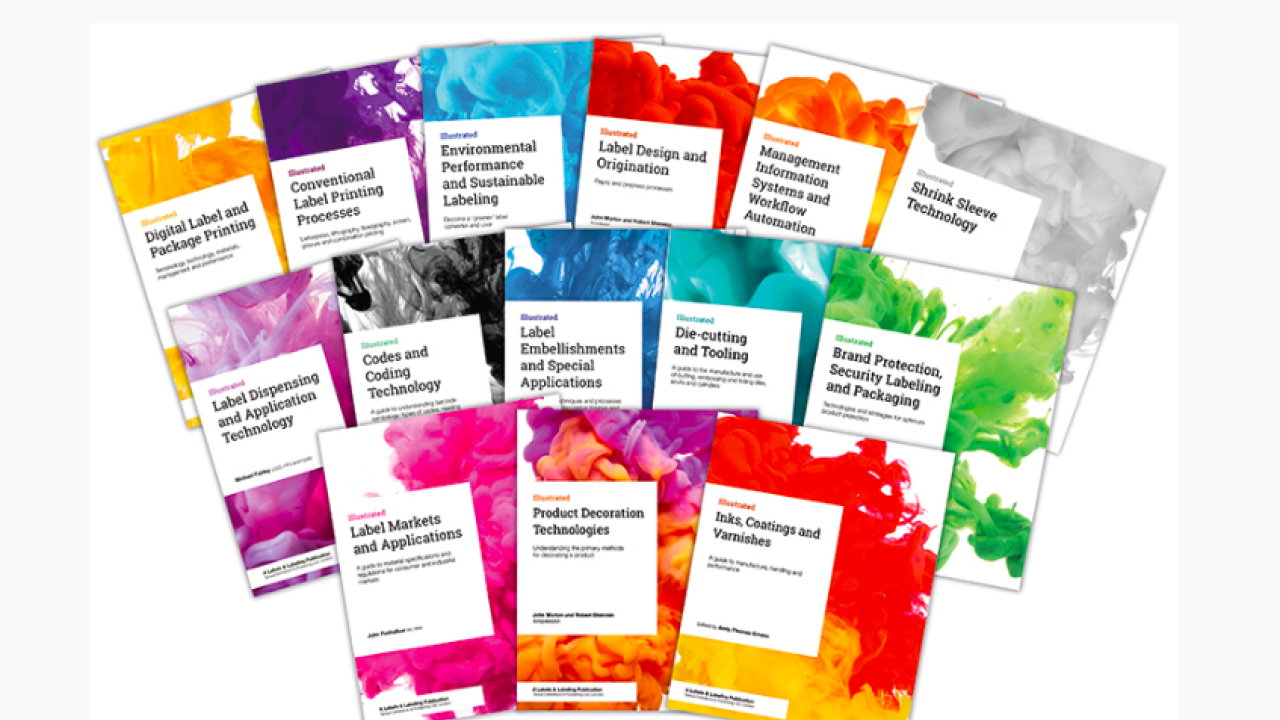Rapid expansion in the Label Academy

At the same time, the industry needs to bring in new people to run existing conventional press technology and retrain and retain its existing workers and bring them up to speed with new and future requirements.
It was a combination of all these factors that lead to the creation of the Label Academy some five years ago. Consisting of a series of self-study modules, combining free access to relevant articles and videos with paid books, the Academy has developed rapidly with some 14 books now available – plus the Encyclopedia of Labels and the History of Labels book – with more in the pipeline. A short summary of all the currently available titles is set out on these pages.
The aim with these books is for each label company to build its own in-house library of titles, all made available for employees to read and study, either individually, or as part of a defined company induction, training and employee development program.
Master classes and workshops have also been introduced as part of the Label Academy program, providing expert information, education and guidance on topics that now include Shrink Sleeve Technology, Management Information Systems and Workflow Automation and Inks, Coatings and Varnishes.
What comes next?
The next new Label Academy book title to be published – expected to be available by the end of the year – will be Flexible Packaging: Materials, technology, markets and applications.
This will be followed in the Spring of 2019 by a completely revised and updated version of the Encyclopedia of Brand Protection and Security Labeling, while a brand-new title, Label Substrates: Their manufacture, characteristics and performance is in the early stages of research and writing. These new editions will bring the total Label Academy books up to the 20 titles that were originally conceived some six years ago.
A review of the existing and new titles is currently underway to establish a regular program of the books that require periodic updating and to look at what new titles might be required for the future. Perhaps there is a need for a Careers in the Label Industry book that converters can provide to schools, colleges and for recruitment purposes? Any readers with ideas or suggestions for new titles can email them to Natalie Tamiollo at Labelexpo (ntamiollo@labelexpo.com).
Label Academy books currently available
Digital Label and Package Printing: Terminology, technology, materials, management and performance
Digital Label and Package Printing incorporates much of the combined knowledge of many of the world’s leading experts to provide a comprehensive guide to understanding how these technologies work – whether electrophotographic liquid and dry toner or inkjet. It also explains the enhanced requirements that digital printing brings to color management, origination and pre-press, workflow, demands on substrates, digital analog and laser finishing, and how converters should look to manage and market the digital printing operation.
Management Information Systems and Workflow Automation
To fulfil the needs of modern label and package printing production, a large number of management information systems (MIS), specialized and niche software solutions and evolving hardware have been developed. While their positive impact on profitability and competitive advantage is undeniable, many have very specific applications. Choosing which is suitable for your operation is a time-consuming and challenging process and getting it wrong can be a costly mistake. Expert guidance can be found in this book.
Inks, Coatings and Varnishes: A guide to manufacture, handling and performance
Inks need to fulfil multiple functions and roles: they must be safe to handle and use by the converter, they must coat a printing plate, yet release easily onto a wide range of different paper and filmic substrates; they must not deform or crack during post-print converting processes involving heat and pressure, or on shrinkable materials; they must resist damage from rubbing and jostling on high speed filling lines and during transit and stacking; and they must remain robust and readable throughout storage and handling by the final end user, whether consumer or industrial. This book covers all these subjects.
Shrink Sleeve Technology
Technological advances have vastly expanded the market for shrink sleeve labels. Today, full body decoration, 360-degree branding, the potential to decorate complex and intricate shapes, the ability to add tamper evidence, abrasion resistance and waterproof printed images are all possible due to constantly developing technology. Shrink sleeve label printing uses a variety of different films, with different degrees of shrink capability. Converters need knowledge of each of these films, along with the image distortion processes, and the shrinkability and performance requirements of inks – all explained in the book.
Environmental Performance and Sustainable Labeling: Become a ‘greener’ label converter and user
This book provides label converters and industry suppliers with information about the environment, sustainability, climate change and waste debate as it affects the label industry, and reviews the legislation, guidelines, directives, protocols and industry initiatives that have been introduced over the past decade.
Conventional Label Printing Processes: Letterpress, lithography, flexography, screen, gravure and combination printing
A valuable resource for explaining the principles of each of the main conventional printing processes used in the production of labels as well as the types of printing equipment used. Although conventional printing is under pressure from digital processes, it remains a potent force in the sector. It is therefore important to have a fundamental understanding of each process, the mechanics behind them and how they are evolving and changing.
Label Design and Origination: Repro and pre-press processes
Written to examine the developments that have taken place in the prepress arena and explores in detail the progress of a typical label job from design through to its arrival on the printing press. The design to print process is quite complex and there are many stages to ensuring that the final printed label meets the expectations of the brand owner. Excellent communication and co-operation between the designer, printer and brand owner are an essential element in delivering a successful result and supply.
Die-cutting and Tooling: A guide to the manufacture and use of cutting, embossing and foiling dies, anvils and cylinders
This book explains the complex and vital role die-cutting and tooling plays. Through a series of detailed explanations, photographs, diagrams and charts, the author provides a detailed look at modern tooling technology – how the tools are manufactured, their use and applications, how they should be handled and stored. It includes a section on troubleshooting on the production line and a glossary of terms to ensure any unknown phrases are quickly understood within context.
Codes and Coding Technology: A guide to understanding barcode symbology, types of codes, reading and verification equipment and industry standards
An up-to-date guide to understanding current barcode symbology, types of codes, scanning and verification equipment, printing technology, and industry standards. Includes a useful glossary of barcoding terminology, providing a valuable resource to materials suppliers, printers/converters, and brand owners.
Label Embellishments and Special Applications: Exploring the techniques and processes used for adding decorative finishes and functionality to labels
Written to explain in detail all current methods of label enhancement. It begins with a thorough review of the more traditional methods such as foiling, embossing and novel printing techniques, and introduces new technologies and innovations including the use of smart and smart active materials, developments in multi-web manufacturing and the introduction of electronics.
Label Dispensing and Application Technology
This book aims to answer key questions around label dispensing and application technology. How is it possible to separate pressure-sensitive face material from the silicone backing? How can labels be placed around corners or into recesses? How are products moved into the correct position for labeling, held steady or rotated on the label application line? Also included is a comprehensive troubleshooting guide for the applicator line.
Brand Protection, Security Labeling and Packaging: Technologies and strategies for optimum product protection
Hundreds of brand protection and security labeling solutions are detailed and explained in the book, including the latest hi-tech methods, such as RFID, taggants, electronic article surveillance (EAS) techniques and holograms. Guidance on developing brand protection and security labeling systems and procedures is also provided.
Product Decoration Technologies: Understanding the primary methods for decorating a product
This book explores the wide variety of product decoration technologies in use today, highlighting their unique characteristics and helping in their identification. It enables the reader to gain a comprehensive insight into the whole decorative process as it relates to consumer packaging – from material selection, print and finishing technology, and to application onto/or integration into the pack itself. The pros and cons of each decoration system are identified, but more importantly, the cost implications underpinning the selection of a particular decoration system are examined.
Label Markets and Applications: A guide to material specifications and regulations for consumer and industrial markets
This title examines each of the main end-user markets in turn. It describes how the label is used to satisfy the consumer, the brand owner and the regulatory authorities in major world markets. It also looks at the changes in label technology, in particular the impact of digital printing, and the ways in which they affect the various end-user sectors.
Stay up to date
Subscribe to the free Label News newsletter and receive the latest content every week. We'll never share your email address.


